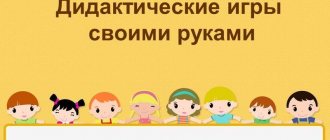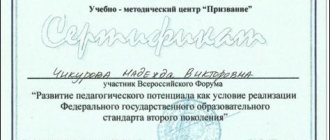Business game “Game is the leading activity of preschoolers” methodological development on the topic
Business game
Topic: “Game is the leading activity of preschoolers”
Goal: To reveal the general strategy of the teacher’s behavior when organizing the game and the specific tactics of his interaction with children in the game. Broadcast the experience of preschool educational institutions on the topic “Game activities of preschoolers”, using active methods of working with teachers.
Tasks:
1. Improve the pedagogical skills of educators
2. To improve the methodological level of teachers in organizing various types of games
3.Promote creative exploration
4. Adjust the work on organizing play activities in a preschool institution.
Participants: teachers of preschool educational institutions of the Romodanovsky municipal district
Draw: Participants of the game collect words and this will be the name of the team
Jury: 3 people
The jury notes the competence, creativity, correctness, completeness of the answer, originality, and creativity of the teachers.
Participants: teachers of preschool educational institutions of the Romodanovsky municipal district
Presenter: - Dear colleagues, we invite you to take part in a business game on the topic: “Game is the leading activity of preschoolers.” During this game, teachers will be able to exchange teaching experience on this topic with each other.
- "Let's play!" - how often in the bustle of life we do not attach importance to this call or request that sounds today from the lips of every child.
And what does he hear in response? - your opinion.
(Answers from participants in the business game: Parents: “Yes, I don’t have time...I can’t...I’m tired...I’m in a hurry...I don’t have time..." - we often say to our child.) And what teachers answer more often: “Go, play” - this answer can often be heard and from the lips of teachers. -Are you ready to agree with me?
Leading:
I. Warm-up: “Guess what we’re talking about?”
A.S. Makarenko: “If a child knows how to play with such toys, this means that he already has a high culture of play and a high culture of activity is emerging. There is a lot of good realism in the material toy, but at the same time there is room for imagination, not just imagination, but great creative working imagination” (substitute object).
Substitute objects are offered: a block and a pyramid.
Assignment: teams need to name as many objects as possible that can be used in a role-playing game.
II.Blitz - a survey on the topic “Russian folk games”.
I ask you questions, you answer them at a fast pace, one at a time.
— What attributes are used in Russian folk games?
(stick, handkerchief, ball, toy) - The main role in the folk game? (driver) - What determines the entire course of the game, regulates the actions and behavior of children? (rules of the game) - Why do you need a counting rhyme in the game? (to choose a driver) - Where are Russian folk games used? (in organizing holidays, matinees, entertainment, walks) - What physical qualities are brought up in Russian folk games? (courage, dexterity, endurance) - Where does the speech material for folk games come from?
(from folklore) - What is the signal to action in a folk game? (word)
Sh. Solving problem situations:
Play out the situation and find ways to solve the problem
1 situation:
Dima is building a large garage for cars. He does everything himself. He keeps all the building materials close to him. The guys sit next to each other and ask: “Give me one plate!” And Dima responded: “I can handle it myself!”
Questions: How do you evaluate Dima’s action? What should the teacher do to support the game without offending Dima?
2. The teacher saw in a neighboring kindergarten that children were interestingly playing fishermen. In order to bring the game to her group, she made the fishing gear herself and suggested the theme of the game to the children.
The game didn’t work out; the teacher always had to tell the children what to do next.
Questions: 1. Explain why the game didn’t work out?
2. How to ensure that all children are active in the game and can play both main and secondary roles.
IV. "Add and explain"
Teams are offered statements by Socrates and A.S. Pushkin (like “cut pictures”).
Assignment: It is necessary to collect and explain statements.
Socrates: “... do not forcefully teach children science, my dear, but through play; then you will better see who is inclined to what.”
A.S. Pushkin “Eugene Onegin”: “With an obedient doll, a child jokingly prepares for decency, the law of the world, and importantly repeats his mother’s lessons to her.”
V. Exercise “Continue the sentence” Teachers take turns being asked to continue their version of the phrases: - “I like didactic games because ......” - “I don’t like didactic games because ....” — “I like role-playing games because I....” -“What I like most is…. Games because...” - “I think that the game is useful because...” - “My favorite game is...., because...” - “I believe that children learn in the game...” - “I don’t like intellectual games because...” - “In my opinion, the most useful games for children are.... because...” - “I think that every child plays games...”
VI.Task for teams:
First Team: Define Directing
Second command: Define dramatization play.
Director's play is a play activity, which is richer and more varied the more interesting the child's real life is, the more extensive his information about the world around him.
Dramatization games are created based on a ready-made plot from a literary work or theatrical performance. The game plan and sequence of actions are determined in advance.
VII.Task for teams:
Without words, with the help of facial expressions and gestures, show a Russian folk tale using attributes.
Team of 3 people - fairy tale “Teremok”.
All the rest are the fairy tale “Chicken - Ryaba”.
Today we talked a lot about the merits of children's play. But it has another advantage. Among the adults around him, the child loves those who play with him more. At the same time, I would like to especially emphasize that neither expensive gifts, nor sweets, nor interesting activities can influence a child’s liking as much as playing together with him. However, it is important to note that play does not happen on its own. Someone must open the world of play to the child and get him interested in it.
At the end of our meeting, I would like to thank you for your cooperation, wish you creative discoveries in our difficult but interesting work, great health, happiness and love.
Productive business game
This game is a type of brainstorming. With its help, it is possible to identify existing problems and outline ways to eliminate them, which can subsequently be included in a draft decision of the teachers’ council or a policy document of an educational institution.
To conduct the game, the team is divided into role groups: teachers, students, parents, administration. The first stage of the groups’ work is conventionally called “negative”. The presenter announces the topic of the game, and the participants of each group must continue the sentence “I am not happy with ...”. All voiced opinions are recorded, and experts, having studied all the records, classify them and formulate the most pressing problems.
After this, they begin the second stage of the game - developing “positives”. The panel of experts voices the problems identified, and the group members now express their ideas regarding the question “What can you offer?”
The third stage involves teamwork. It is necessary to select the most productive opinions from all the proposed ideas and make a joint decision. As a result, a program to improve educational practice is being developed.
Business game for preschoolers “Day of the Understudy in Kindergarten”
The purpose of the game is to get acquainted with the organization of the work of a kindergarten, with the complexity and responsibility of the work of employees of a preschool educational institution, to develop an understanding of the general involvement of not only the team of employees of the educational institution, but also children and parents in the work of the kindergarten.
Stage 1 of the game: familiarization with the areas of work and functional responsibilities of kindergarten workers.
Stage 2 of the game: distribution of roles for game participants: teacher, assistant teacher, physical education and music workers, parents. 2-3 people are selected for each role.
Stage 3: the participants in the game, with the help of adult specialists whom they will “duplicate,” develop an action plan for the duration of their duplication.
Stage 4: game participants perform their role responsibilities for one to two hours. This could be holding an event, a class, or a walk in the younger groups of a kindergarten. Adults monitor children's performance of their roles.
Stage 5: the game participants, together with those whom they duplicated, discuss the game process, achievements and mistakes. Children make their proposals for organizing the processes that they carried out during the performance of their roles.



